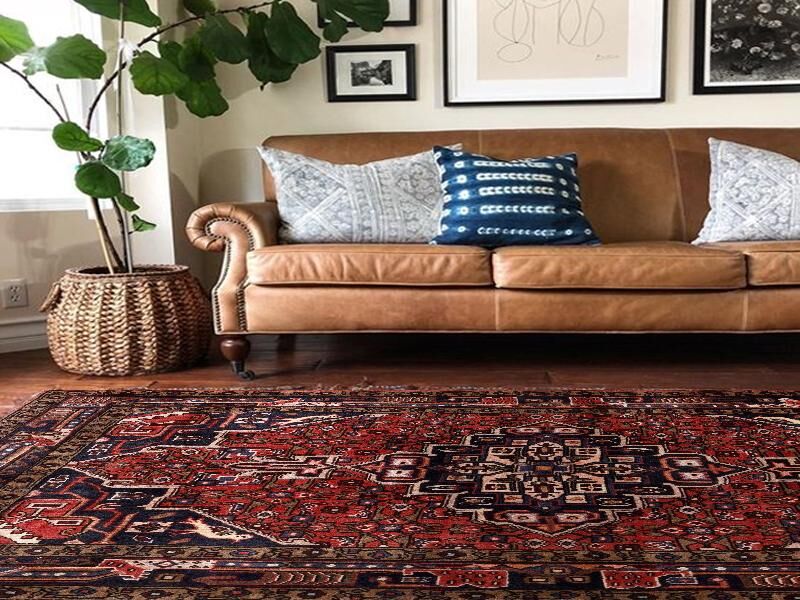History and Origins of Red Iranian Tribal Rugs

For centuries, the artistry of Iranian carpets has been woven into the cultural fabric of the region, creating not just functional floor coverings but timeless pieces of art. Among the myriad styles that have emerged from this ancient craft, the allure of Irani carpets stands out, particularly the enchanting world of red Persian rugs. These intricate creations have a history as rich and vibrant as the hues they boast.
The Cultural Tapestry of Iranian Carpets
Iranian carpets, also known as Irani rugs or Persian carpets from Iran, have deep roots in the country's cultural heritage. Dating back to ancient times, the craft of carpet weaving has been passed down through generations, with each rug telling a unique story. The art of weaving is not merely a skill; it's a cultural expression, reflecting the aesthetics, beliefs, and traditions of the Iranian people. Within this cultural tapestry, the significance of Iranian rugs transcends utility, transforming into a form of artistic expression that graces homes and museums worldwide.
The craft of carpet weaving in Iran, also referred to as Irani rugs, has a historical depth that mirrors the diverse cultural influences that have shaped the nation. Dating back to the time of the Persian Empire, the art of carpet making has evolved with the ebb and flow of political, social, and artistic trends. Persian carpets from Iran, whether Iranian tribal rugs or those from urban centers, are revered for their meticulous craftsmanship and exquisite designs. The meticulous knotting techniques and the careful selection of materials, often including silk and wool, contribute to the durability and timeless beauty of Irani carpets. Today, these carpets are not merely household items; they are cherished heirlooms that carry within their fibers the spirit of generations past.
The Allure of Red Persian Rugs in Living Spaces
Among the diverse array of red Persian rugs, the vibrant red hues hold a special place. These rugs are not just floor coverings; they are statements that speak volumes about the dwellers' taste and style. In red Persian rug living room ideas, the rug takes center stage, becoming the focal point of the space. The rich red tones evoke warmth and sophistication, seamlessly blending tradition with modern aesthetics. Whether adorned with intricate patterns or minimalistic designs, red rugs contribute a touch of opulence to any living space, creating an ambiance that is both inviting and culturally rich.
In the realm of interior design, red Persian rugs play a pivotal role in elevating the aesthetics of living spaces. Beyond their functional purpose, these rugs serve as art pieces that evoke emotions and tell stories. Red, with its deep cultural significance, becomes a symbol of passion, prosperity, and warmth within the home. Red Persian rug living room ideas often revolve around complementing colors, textures, and furniture, ensuring that the rug becomes the centerpiece of the space. The timeless appeal of red rugs is not just a trend; it's a testament to the enduring allure of Persian craftsmanship that transcends time and design eras.
The Nomadic Legacy: Tribal Persian Rugs
Deep within the annals of Iranian carpet history lie the tribal Persian rugs, embodying the nomadic spirit of certain Iranian communities. Crafted by hand with skills passed down through generations, these rugs are more than just decorative pieces; they are reflections of a nomadic lifestyle. In the creation of tribal rugs, the weavers incorporate symbols and patterns that narrate the story of their wanderings and cultural identity. Each rug is a masterpiece that captures the essence of tradition, making it a unique and treasured possession. The tribal oriental rugs showcase a connection to nature, tradition, and a way of life that is both historic and timeless.
The tradition of weaving tribal Persian rugs has been preserved by nomadic communities, each rug acting as a portable piece of their cultural identity. These rugs often feature bold geometric patterns, reflecting the weavers' closeness to nature and their surroundings. The nomadic legacy is not just in the design but also in the very process of creation, where weavers work intimately with the land, the sheep, and the dyes they source from their environment. Persian tribal rugs are not just floor coverings; they are narratives told in vibrant colors and intricate knots, weaving together the stories of the nomadic tribes that have crafted them for centuries.
In conclusion, the history and origins of red Iranian tribal rugs are deeply intertwined with the cultural narrative of Iran. From the intricate craftsmanship of Iranian carpets to the vibrant allure of red Persian rugs and the nomadic legacy embodied in tribal Persian rugs, each piece is a testament to the artistic prowess and cultural richness of the Iranian people. As these rugs continue to grace homes and transcend geographical boundaries, they remain not just floor coverings but living pieces of art that bridge the past with the present.


